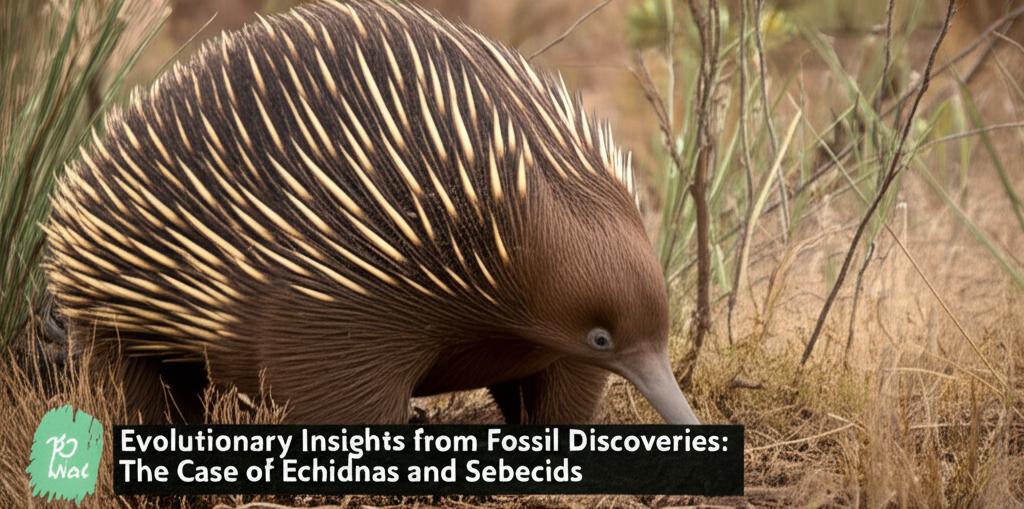Fossil discoveries continue to reshape our understanding of evolutionary pathways, offering surprising insights into the history of life on Earth. Recent findings concerning echidnas and sebecids provide compelling examples of how new fossil evidence can challenge long-held theories and reveal unexpected evolutionary twists.
Echidnas: A Surprising Aquatic Past?For a long time, the prevailing view was that echidnas, the spiny, egg-laying mammals of Australia and New Guinea, evolved from a land-dwelling ancestor. This ancestor was also thought to be the progenitor of the platypus, which subsequently adapted to a semi-aquatic lifestyle while echidnas remained terrestrial. However, a recent re-examination of a 108-million-year-old fossilized humerus (arm bone) is turning this theory on its head.
The fossil in question, belonging to an extinct monotreme species named Kryoryctes cadburyi, was discovered about 30 years ago at Dinosaur Cove in Victoria, Australia. While its external appearance initially suggested a closer resemblance to echidnas, new analysis using high-resolution microCT scans to study the bone's internal microstructure has revealed features more akin to those of a platypus and other semi-aquatic mammals. These features include thick, heavy bone walls and a small medullary cavity (the hollow space inside bones). Such bone density is common in animals that need to reduce buoyancy to dive and forage underwater, acting like a natural weight belt.
This new evidence suggests that the common ancestor of both echidnas and platypuses may have been semi-aquatic. If this interpretation holds, it implies a remarkable evolutionary reversal for echidnas: their ancestors would have transitioned from an aquatic or semi-aquatic lifestyle back to a fully terrestrial one. This is a very rare evolutionary trajectory, as most documented transitions involve land mammals adapting to aquatic environments (like whales and seals), not the other way around.
Further supporting this hypothesis are certain modern echidna traits that could be remnants of an aquatic heritage. These include backward-facing hind feet, a diving reflex, sensory receptors in their beaks (though fewer than in platypuses, they might be a vestige of a platypus-like bill seen in echidna embryos), and unusually high levels of oxygen-storing myoglobin.
The fossil record for monotremes is still sparse, but these findings from Kryoryctes cadburyi highlight the importance of reinvestigating existing fossils with new technologies. Paleontologists are hopeful that further discoveries, particularly from Mesozoic opalised fossil sites in Lightning Ridge, New South Wales, will shed more light on the early evolution of these unique mammals.
Adding to the complexity of early monotreme evolution, recent discoveries at Lightning Ridge have also revealed a surprising diversity of these egg-laying mammals around 100 million years ago. Fossils of three previously unknown species, including one nicknamed "echidnapus" (Opalios splendens), suggest an "Age of Monotremes." Opalios splendens exhibited a mix of features: an overall anatomy similar to a platypus but with a jaw and snout more like an echidna. This discovery, along with others like Dharragarra aurora (the earliest known platypus), paints a picture of Australia as a land teeming with diverse monotremes before marsupials became the dominant mammals.
Sebecids: Apex Predators with a Longer Reign and Wider ReachSebecids were a fascinating group of terrestrial crocodylomorphs, relatives of modern crocodiles, that played the role of apex predators in South America after the extinction of the non-avian dinosaurs. Unlike their living cousins, sebecids had long limbs positioned directly under their bodies, suggesting they were active land hunters, capable of running down prey. They possessed tall, narrow heads and serrated teeth, similar to carnivorous theropod dinosaurs. Some species could reach impressive lengths of up to 20 feet.
For a long time, it was believed that sebecids went extinct around 11 million years ago and were largely confined to South America, with some limited presence in Europe. However, recent fossil discoveries in the Caribbean are dramatically rewriting this narrative.
Fossilized teeth suggestive of sebecids had been found on Caribbean islands like Cuba and Puerto Rico over the years, but their identity remained uncertain. More definitive evidence emerged with the discovery of a 6-million-year-old fossilized tooth and vertebrae in the Dominican Republic. The vertebrae, in particular, showed flattened anatomy characteristic of sebecids, distinguishing them from other crocodyliforms.
These Caribbean fossils are significantly younger than the last known South American sebecids, with some Dominican Republic specimens dating to as recently as 4.5 million years ago. This implies that the Caribbean islands served as a final refuge for these formidable predators, allowing them to survive for millions of years after they had vanished from the mainland.
The presence of these large, terrestrial predators in the Caribbean also has implications for understanding ancient ecosystems and biogeography. The open sea between South America and the Caribbean would have been a significant barrier for land-based animals. The sebecid discoveries lend support to the "GAARlandia" hypothesis, which proposes the existence of temporary land bridges or island chains that facilitated faunal exchange between the two regions. It's possible that a cooling climate over millions of years gradually pushed sebecids into tropical latitudes, with their range eventually contracting to these islands.
The discovery of Ogresuchus furatus, a 71.5-million-year-old sebecid from Spain, also significantly pushed back the known origin of the Sebecidae family, making it the oldest known member. This finding suggests sebecids might have originated before the complete breakup of the supercontinent Gondwana. Another recently described Patagonian sebecid, Tewkensuchus salamanquensis, from the early Paleocene (just after the dinosaur extinction), is notable for its large size (estimated around 300 kg). This indicates that some large-bodied terrestrial vertebrate lineages did survive the Cretaceous-Paleogene extinction event.
These ongoing fossil discoveries underscore the dynamic nature of paleontology. Each new find has the potential to refine, and sometimes radically alter, our understanding of how life on Earth has evolved, revealing intricate stories of adaptation, diversification, and extinction across vast stretches of geological time.

